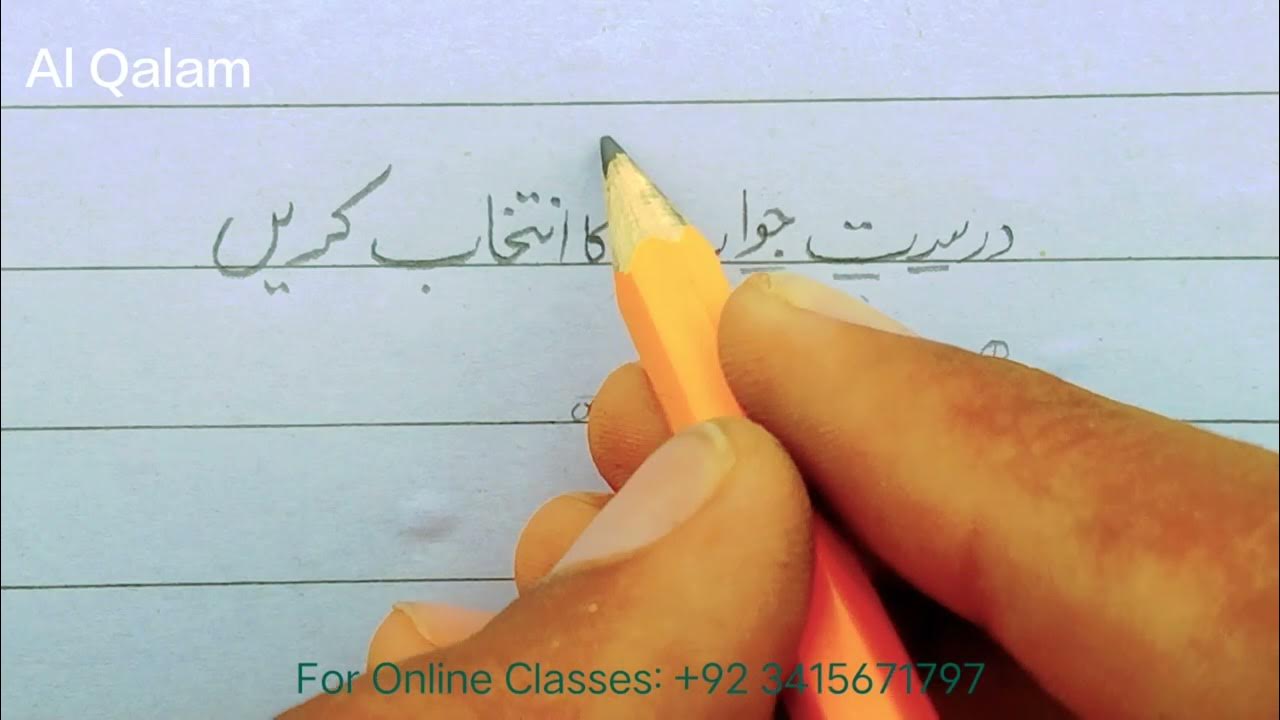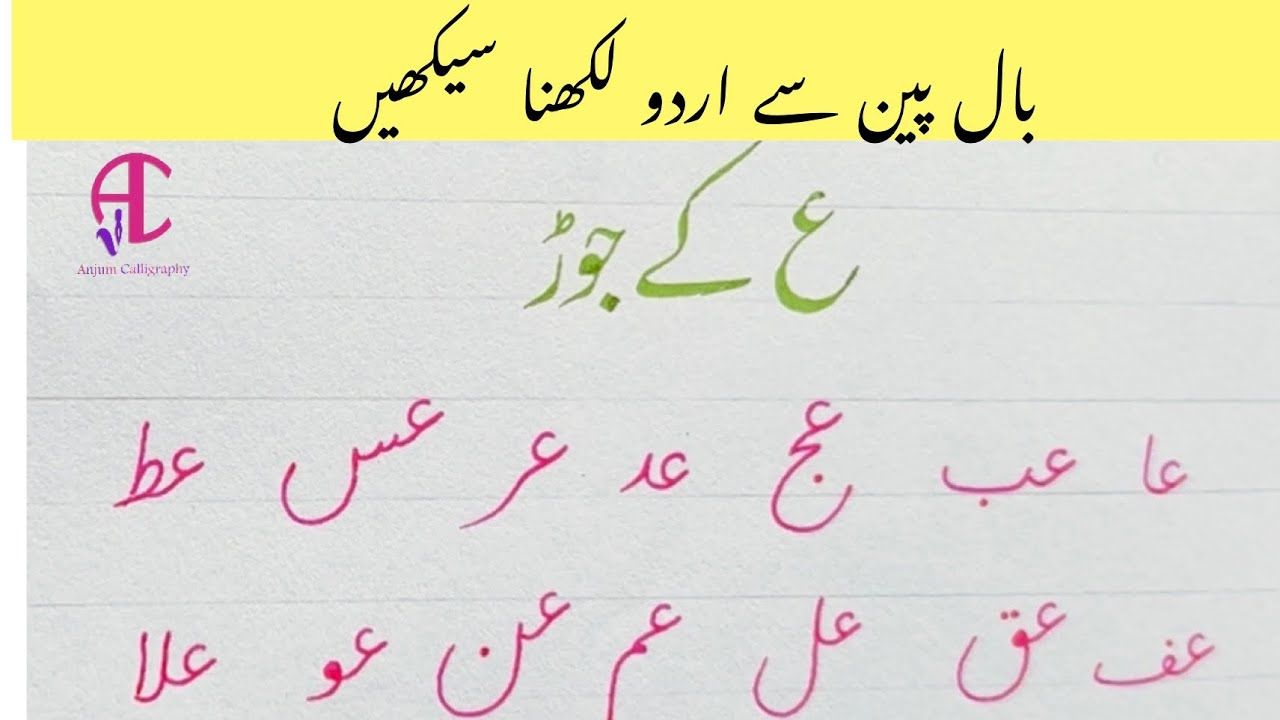Improving your Urdu handwriting can be both a fulfilling and enjoyable journey! Whether you’re a student looking to enhance your notes, a professional wanting to make a good impression, or someone passionate about the language, neat handwriting can make a significant difference. In this post, we'll explore some easy techniques to help you achieve cleaner, more legible Urdu handwriting.
Common Challenges in Urdu Handwriting

When it comes to Urdu handwriting, many of us face similar hurdles that can impede our progress. Understanding these challenges is the first step towards improvement. Let's explore some of the most common issues:
- Complex Script: Urdu is a beautiful language, but its script can be complex. The joins and curves of letters can be tricky to master. This complexity often leads to frustration, which can result in poor handwriting.
- Inconsistent Size: Another challenge many face is maintaining consistent letter size and spacing. Some letters may end up larger or smaller than others, leading to a disjointed appearance on paper.
- Pressure Control: Many people struggle with how much pressure to apply when writing. Too much pressure can cause your pen to drag on the paper, while too little may cause the letters to look faint or undefined.
- Alignment Issues: Keeping your writing aligned can be a challenge, especially on blank pages. Many people find their letters drifting upwards or downwards without the structure of lined paper.
- Letter Connection: The fluidity of connecting letters in Urdu can often be difficult. Some might hesitate or make abrupt stops between letters, which can create breaks in the flow of writing.
By recognizing these challenges, you can begin to focus on specific areas for improvement. It’s essential to be patient with yourself as you work through these obstacles. Practice is key, but so is understanding what exactly you need to practice. With the right mindset and techniques, you can overcome these hurdles and develop a beautiful handwriting style in Urdu!
Also Read This: How to Shape Your Eyebrows with Thread on Dailymotion
3. Essential Techniques for Better Urdu Handwriting

Improving your Urdu handwriting doesn't have to be a daunting task. With the right techniques, you can transform your writing into something that’s not only legible but also beautiful. Here are some essential techniques that can help you enhance your Urdu handwriting:
- 1. Consistent Practice: Just like learning any new skill, the key to better handwriting is practicing regularly. Set aside at least 15-30 minutes daily to work on your writing. Consistency will lead to gradual improvement.
- 2. Choose the Right Tools: The pen you use can make a big difference. Try different types of pens—gel pens, fountain pens, or even simple ballpoint pens—to see which feels the best for you. Make sure you have quality paper that allows smooth writing.
- 3. Focus on Posture: Your writing posture can greatly affect your handwriting quality. Sit up straight, hold the pencil or pen comfortably, and ensure your hand is relaxed as you write.
- 4. Use Guidelines: When practicing Urdu, it’s helpful to write on lined paper or use graph paper. The lines will guide the size and slope of your letters, allowing you to maintain consistency.
- 5. Slow Down: In our fast-paced world, it’s easy to rush through writing. However, slowing down allows for more control over your pen strokes, leading to neater handwriting. Take your time to form each letter carefully.
- 6. Break Down Letters: Spend time focusing on individual letters, especially the ones that give you trouble. Practice writing them repeatedly until you find a style that feels comfortable and looks good.
- 7. Study Expert Handwriting: Look for samples of beautifully written Urdu. Analyzing the curves and styles of other writers can give you insights into improving your own writing.
Remember, good handwriting isn’t about perfection; it’s about legibility and style. Gradually implement these techniques into your practice sessions, and you'll notice a remarkable improvement over time!
Also Read This: How to Change Family Filter on Dailymotion for Safe Viewing
4. Practice Exercises for Urdu Calligraphy
Now that you've learned some essential techniques, it's time to dive into practical exercises that will refine your Urdu calligraphy. These exercises are tailored to help you develop muscle memory and improve your letter formation. Let's get started!
| Exercise | Details |
|---|---|
| 1. Basic Strokes | Practice individual strokes that make up Urdu letters. These include loops, straight lines, and curves. Repeat each stroke 10-15 times to build muscle memory. |
| 2. Letter Formation | Choose a letter of the Urdu alphabet daily. Write it in various sizes and styles. Once comfortable, try combining it with other letters to form simple words. |
| 3. Write Simple Words | Start with basic Urdu words like 'کتاب' (book) or 'پانی' (water). Focus on writing them multiple times while ensuring consistency in size and slant. |
| 4. Connect Letters | Once you're comfortable with individual letters, practice writing connected letters. This will help you write more fluently and improve the flow of your handwriting. |
| 5. Form Sentences | Write simple sentences and phrases in Urdu. This exercise will challenge you to maintain consistent size and spacing across multiple letters. |
To make your practice more enjoyable, try listening to music or audiobooks while you write. The right environment can spark creativity and ease the process. Remember, improvement takes time, so be patient with yourself. Enjoy the journey of refining your Urdu handwriting—your hard work will surely pay off!
Also Read This: Is Dailymotion Safe to Use? Here is What You Need to Know
5. Tools and Resources for Enhancing Handwriting
Improving your Urdu handwriting doesn't have to be a daunting task! There are plenty of tools and resources that can make this journey a lot easier and more enjoyable. Let’s explore some of the best options available to you!
1. Handwriting Workbooks: These workbooks are specifically designed for learning and practicing Urdu script. They usually contain tracing exercises, dotted letters, and ample space for free writing. Some popular ones to consider include:
- Urdu Handwriting Practice Book by Pearson
- Fun with Urdu Writing by Rupa Publications
- Calligraphy Workbooks that focus on Urdu script
2. Online Courses and Tutorials: The internet is a treasure trove of resources! Websites like YouTube have numerous tutorials that not only show you how to form letters but also emphasize the *flow and style of Urdu handwriting. Consider checking out:
- Urdu Calligraphy Basics – A video series
- Websites offering structured Urdu handwriting courses
- Online forums for peer feedback and tips
3. Digital Apps: If you prefer a modern approach, there are apps tailored to improve handwriting. Apps like Khan Academy or Writing Wizard can provide guided practice and immediate feedback. Some apps also have interactive features that make practicing more engaging.
4. Personalized Feedback: Sometimes, an experienced tutor or teacher can provide invaluable insights. Whether online or in person, having someone critique your writing can help you refine your techniques and discover areas that need improvement.
5. Writing Tools: Believe it or not, the pen you choose can make a world of difference! Experiment with different types of pens and papers. Some individuals find that gel pens or calligraphy pens help them write more smoothly, while others prefer traditional ballpoint pens. Don’t hesitate to try out:
- Gel pens for smooth writing
- Fountain pens which can improve grip and control
- Specialty papers designed for handwriting practice
By utilizing these tools and resources, you’ll soon notice a significant improvement in your Urdu handwriting. Remember, the key is consistency and practice!
Also Read This: How to Use Dailymotion for Inspirational Stories and Holiday Specials
6. Setting Goals for Handwriting Improvement
Setting clear and achievable goals can make the process of improving your Urdu handwriting both structured and rewarding. Think of your handwriting journey like a fun game – it’s all about reaching those milestones one step at a time!
1. Short-term Goals: Start small. For instance, aim to practice your handwriting for just 10-15 minutes each day. You might want to focus on specific letters or words that you find challenging. Here are some ideas:
- Master the alphabet in a week
- Practice writing ten common phrases each day
- Spend one week focusing solely on improving the spacing between letters
2. Long-term Goals: After you’ve established a routine with your short-term goals, think about what you want to achieve in the long run. Maybe you'd like to be able to write an entire paragraph without pausing. Consider setting goals like:
- Writing a short letter in Urdu each week
- Being able to write your favorite Urdu poem beautifully
- Crafting a handwritten diary entry every day for a month
3. Track Your Progress: One of the most motivating ways to stay on track is to visually see your growth. Create a tracking system*; this could be a simple writing journal where you document your daily or weekly practice. Include:
- Dates and times spent practicing
- Letters or words you focused on
- Reflections on what felt easy or difficult
4. Celebrate Achievements: Once you hit a goal, celebrate it! Whether it's treating yourself to a favorite snack or taking a moment to reflect on how far you've come, acknowledging your progress will keep you motivated.
By setting clear and attainable goals, you will not only enhance your Urdu handwriting but also enjoy the journey of learning. Remember, every small step brings you closer to achieving beautiful handwriting!
Also Read This: How to Serve Tea to Guests with Elegance and Style
7. Monitoring Progress and Staying Motivated
Improving your Urdu handwriting is a rewarding journey, but it can also be a bit challenging at times. To keep yourself engaged and motivated, it’s essential to monitor your progress regularly. Here are some easy techniques to help you do just that:
- Use a Handwriting Journal: Keep a dedicated journal where you can record your daily or weekly handwriting practice. Date each entry and write a few sentences or words in Urdu. Looking back at older entries can provide a visual indication of your improvement.
- Set Specific Goals: Rather than a vague goal like "improve handwriting," set specific, measurable goals. For instance, aim to perfect a particular letter or write a short paragraph with consistent spacing. This clarity will keep you focused.
- Take Before and After Photos: Snap a picture of your handwriting at the beginning of your journey. After a month of practice, take another photo. This visual comparison can be incredibly motivating as you realize how far you've come!
- Share Your Work: Don’t hesitate to show your handwriting to friends or join an online community. Feedback from others can boost your confidence, and they can tips and improvements you might not have considered.
Staying motivated is another critical element of progress. Here are some strategies to keep your enthusiasm high:
- Celebrate Small Wins: Acknowledge your improvements, no matter how small. Did you write a letter without smudges? Did a friend compliment your handwriting? Celebrate these moments!
- Consistency is Key: Even on days when you don't feel motivated, try to practice for just 5-10 minutes. This consistency fosters discipline and gradually becomes a habit.
- Incorporate Fun: Mix up your practice with creative activities. Write out your favorite Urdu poems, quotes, or song lyrics. Making the practice enjoyable will help you stay engaged.
Remember, handwriting improvement is a gradual process, and it’s important to be patient with yourself. By monitoring your progress and finding ways to stay motivated, you’ll find that enhancing your Urdu handwriting can be not just a goal but an enjoyable journey.
8. Conclusion: Embrace Your Journey to Better Urdu Handwriting
As we wrap up our discussion on improving Urdu handwriting, it’s important to remember that everyone’s journey is unique. Embracing this journey—through successes and challenges—is part of the fun and growth in learning a new skill. Here are some key takeaways to keep in mind:
- Focus on Consistency: Improvement comes with practice. Even short, daily sessions can yield remarkable results over time.
- Celebrate Your Progress: Each step, big or small, deserves recognition. Celebrate your improvements to stay encouraged!
- Stay Open to Learning: There’s always more to learn, whether it's new styles, tips, or tools. Embrace each opportunity to expand your knowledge.
Every time you pick up your pen to write in Urdu, remind yourself that you're not just forming letters—you’re connecting with a beautiful language rich in culture and history. Allow yourself to make mistakes; they’re part of learning! As you progress, you’ll find that your handwriting reflects not just your skill but also your personality and creativity.
So here’s to your journey! May your Urdu handwriting become a reflection of your dedication and passion. Keep practicing, stay motivated, and most importantly, have fun with it!
 admin
admin








